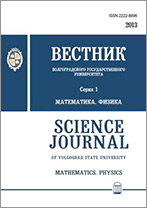|
|
Vestnik Volgogradskogo gosudarstvennogo universiteta. Seriya 1. Mathematica. Physica, 2014, Issue 3(22), Pages 41–55
(Mi vvgum53)
|
 |
|
 |
Mathematics
On equicontinuity of one family of space mappings with unbounded characteristic
E. A. Sevostyanov, D. S. Dolya
Institute of Applied Mathematics and Mechanics, National Academy
of Sciences of Ukraine
Abstract:
In the present paper, some class of space mappings satisfying
geometric estimates with respect to some outer measure, that is
conformal modulus of families of curves, is studied. It is proved
the equicontinuity of above classes in a closure of a domain
provided that the majorant corresponding to a distortion of families
of curves has a finite mean oscillation at every point, or satisfies
some other conditions.
Let $D$ be a domain in ${\Bbb R}^n,$ $n\ge 2,$ and $f:D\rightarrow
{\Bbb R}^n$ be a continuous mapping. Set $\overline{{\Bbb
R}^n}={\Bbb R}^n\cup\{\infty\},$ let $m$ be the Lebesgue measure in
${\Bbb R}^n,$ and $M$ be the conformal modulus of families of
curves. Given a domain $D$ and two sets $E$ and $F$ in
${\overline{{\Bbb R}^n}},$ $n\ge 2,$ $\Gamma (E,F,D)$ denotes the
family of all paths $\gamma:[a,b]\rightarrow {\overline{{\Bbb
R}^n}}$ which join $E$ and $F$ in $D$, i.e., $\gamma(a)\in E,$
$\gamma(b)\in F$ and $\gamma(t)\in D$ for $a<t<b.$ Denote by
$S(x_0,r_1)$ and $S(x_0,r_2)$ the corresponding boundaries of the
spherical ring $A(x_0,r_1,r_2) = \{ x\in{\Bbb R}^n :
r_1<|x-x_0|<r_2\}$ and let $S_i=S(x_0, r_i),$ $i=1,2.$ Given a
(Lebesgue) measurable function $Q: D \rightarrow [0,\infty]$, a
mapping $f:D\rightarrow {\Bbb R}^n$ is called ring $Q$–mapping
at a point $x_0\in D$ if
\begin{equation}
M\left(f(\Gamma(S_1, S_2, A(x_0,r_1,r_2)))\right) \le
\int\limits_{A(x_0,r_1,r_2)} Q(x)\cdot \eta^n(|x-x_0|)dm(x)\tag{1}
\end{equation}
for $0<r_1<r_2< r_0={\rm dist}(x_0,\partial D),$ and
for every Lebesgue measurable function $\eta: (r_1,r_2)\rightarrow
[0,\infty ]$ such that $\int\limits_{r_1}^{r_2}\eta(r)dr\ge 1.$ By
analogy, given a Lebesgue measurable function $Q:{\Bbb
R}^n\rightarrow [0, \infty],$ $Q(x)\equiv 0$ for every $x\not\in D,$
we say that a mapping $f:D\rightarrow \overline{{\Bbb R}^n}$ is a
ring $Q$-mapping at $x_0\in \overline{D},$ $x_0\ne \infty,$ if
for every $r_0=r(x_0)$ and $A=A(r_1,r_2,x_0)$ the relation (1) holds
for every continua $E_1\subset \overline{B(x_0, r_1)}\cap D$ and
$E_2\subset \left(\overline{{\Bbb R}^n}\setminus B(x_0,
r_2)\right)\cap D.$
Note that analytic functions ($n=2$) are ring $Q$-mappings with
$Q\equiv 1,$ ant that the so-called mappings with bounded distortion
are ring $Q$-mappings with $Q\le K=const.$ We say that a function
$\varphi:D\rightarrow {\Bbb R} $ has finite mean oscillation
at a point $x_0 \in {D} $ if
$\limsup\limits_{\varepsilon\rightarrow 0}\frac{1}{\Omega_n\cdot
\varepsilon^n} \int\limits_{B(x_0, \,\varepsilon)}
|\varphi(x)-\widetilde{\varphi_{\varepsilon}}|\,dm(x)< \infty$ where
$\widetilde{\varphi_{\varepsilon}}= \frac{1}{\Omega_n\cdot
\varepsilon^n}\int\limits_{B( x_0, \,\varepsilon)} \varphi(x)\,
dm(x)\,.$ We say that a boundary $\partial D$ of $D$ is
strongly accessible at $x_0\in
\partial D$ if, for every neighborhood $U$ of $x_0$ there exists a compactum
$E\subset D,$ a neighborhood $V\subset U$ of $x_0$ and a number
$\delta
>0$ such that $M(\Gamma(E,F, D))\ge \delta$ for every continua $F$ in $D,$
$F\cap\partial U\ne\varnothing\ne F\cap\partial V.$ It is known
that, in particular, all convex bounded domains have strongly
accessible boundaries.
Given domains $D,$ $D^{\,\prime}\subset {\Bbb R}^n,$ $z_1, z_2\in
D,$ $z_1\ne z_2,$ $z_1^{\prime},$ $z_2^{\prime}\in D^{\prime}$ and
Lebesgue measurable function $Q(x): {\Bbb R}^n\rightarrow [0,
\infty]$ obeying $Q(x)\equiv 0$ for $x\not\in D,$ denote
$\frak{R}_{z_1, z_2, z_1^{\,\prime}, z_2^{\,\prime}, Q}(D,
D^{\,\prime})$ a family of all ring $Q$-homeomorphisms
$f:D\rightarrow D^{\,\prime}$ satisfying to (1) in $\overline{D},$
$f(D)=D^{\,\prime},$ such that $f(z_1)=z_1^{\prime},\quad
f(z_2)=z_2^{\prime}\,.$ Given a Lebesgue measurable function
$Q\colon{\Bbb R}^n\rightarrow[0, \infty]$ and $x_0\in{\Bbb R}^n,$
$q_{x_0}(r)$ is integral mean value of $Q$ under sphere $S(x_0, r).$
Denote $q_{x_0}^*(r)$ a mean integral value of
$
Q^*(x)=\begin{cases} Q(x), & Q(x)\ge 1,\\
1, & Q(x)<1
\end{cases}
$ under the sphere $S(x_0, r).$ Now we have the following.
Theorem. Let a domain $D$ be locally connected at all boundary
points, $\partial D^{\,\prime}$ is strongly accessible, and $Q(x)$
satisfies for every $x_0\in\overline D$ at least one of the
following conditions: 1) $Q(x)\in FMO(x_0)$; 2)
$q_{x_0}(r)=O([\log\frac{1}{r}]^{n-1})$ at $r\rightarrow 0$; 3) for
some $\delta(x_0)>0,$ $\int\limits_{0}^{\delta(x_0)}\frac{dt}{t{q_{x_0}^*}^{1/(n-1)}(t)}=\infty.
$ Then every $f\in \frak{R}_{z_1, z_2, z_1^{\,\prime}, z_2^{\,\prime},
Q}(D, D^{\,\prime})$ has a continuous extension $\overline
f\colon\overline D\rightarrow\overline {D^{\,\prime}}$, moreover, a
family $\overline{\frak{R}_{z_1, z_2, z_1^{\,\prime},
z_2^{\,\prime}, Q}(D, D^{\,\prime})}$ which consists of all extended
mappings mentioned above, is equicontinuous (normal) in $\overline
D$.
Keywords:
mappings with bounded and finite distortion, boundary behavior of space mappings,
equicontinuity, continued extension to a boundary.
Citation:
E. A. Sevostyanov, D. S. Dolya, “On equicontinuity of one family of space mappings with unbounded characteristic”, Vestnik Volgogradskogo gosudarstvennogo universiteta. Seriya 1. Mathematica. Physica, 2014, no. 3(22), 41–55
Linking options:
https://www.mathnet.ru/eng/vvgum53 https://www.mathnet.ru/eng/vvgum/y2014/i3/p41
|

|




 Contact us:
Contact us: Terms of Use
Terms of Use
 Registration to the website
Registration to the website Logotypes
Logotypes








 Citation in format
Citation in format 